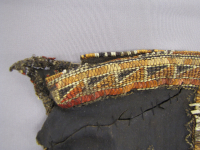Mocassins, Moccasins
Mocassins, Moccasins
Mocassins, Moccasins






This pair of black-dyed hide moccasins, worked in porcupine quill in geometric and curvilinear patterns, is from the Bibliothèque Nationale du France and is now in the Musée du quai Branly. They date from before 1792.
MQB catalogue and style.
MQB catalogue and archives.
Read More About This Relative
Black dyed, smoked hide; porcupine quill,red, gold-orange, white, black; cotton thread, repairs.
Center seam with one band of zigzag quill work over the seam. Heel seam is also covered with a band of zigzag quill work. The heel seam ends with two folds, one on each side of the seam. Not a T seam.
A wavy line of oversewn quill is on either side of the heel band of zigzag.
Two motifs outlined in oversewn quill on the sides of the moccasins are similar to the pattern on a print cotton dress worn by a doll from the collection of Raphael Bischoffsheim, 71.1878.33.11. The doll, with a trade silver medallion, is probably from a later date than the moccasins, which leaves an interesting question about the similarity of the motifs.
The geometric motifs on the band at the top of the moccasins are similar to the motifs on ceramic vessels made by the Huron-Wendat in the sixteenth and early seventeenth centuries.
An unusual feature of these moccasins is that like several other pairs in this collection, the two moccasins are not the same size, one is noticeably bigger.
Pieces of the soles of the moccasins have been cut out.
Material in the Bibliothèque Nationale du France was collected before 1792.
Provenance
The ethnographic works from the Bibliothèque Nationale du France are located in the Musée du quai Branly in Paris. These ethnographic works were brought together in this collection at the time of the French Revolution, around 1792. Many of these works came from the Jardin du Roi, the collection of the French kings. In 1792, inventories were made of the possessions of aristocratic French families in Paris and the provinces and many objects were selected to be added to the Bibliothèque Nationale, which was the national collection of the new Republic. Ethnographic material from the Bibliothèque Nationale was located at the Musée d'ethnographie du Trocadéro, then the Musée de l’Homme, and is now in the Musée du quai Branly.
About This GRASAC Record
This record was created by Anne de Stecher during an RAship for Prof. Ruth Phillips.
This record will be open access on the completion of Anne de Stecher's dissertation, 2011.













MQB catalogue and style.
 Knowledge Sharing Platform
Knowledge Sharing Platform





